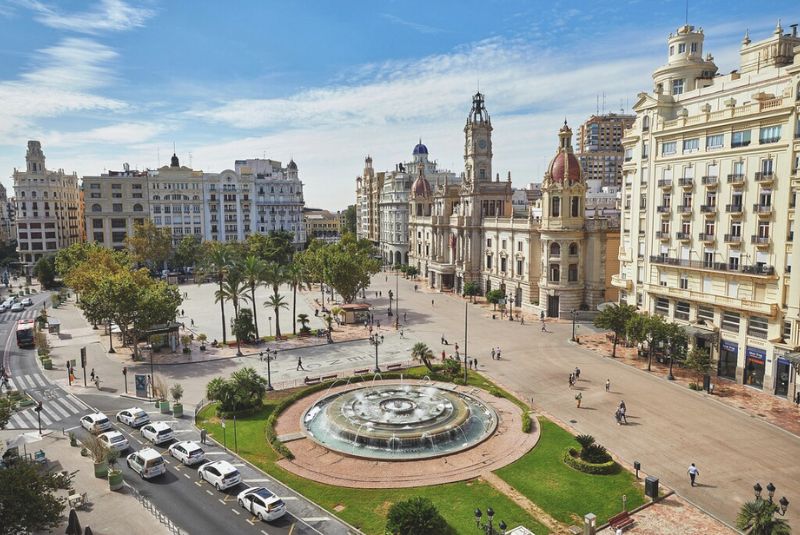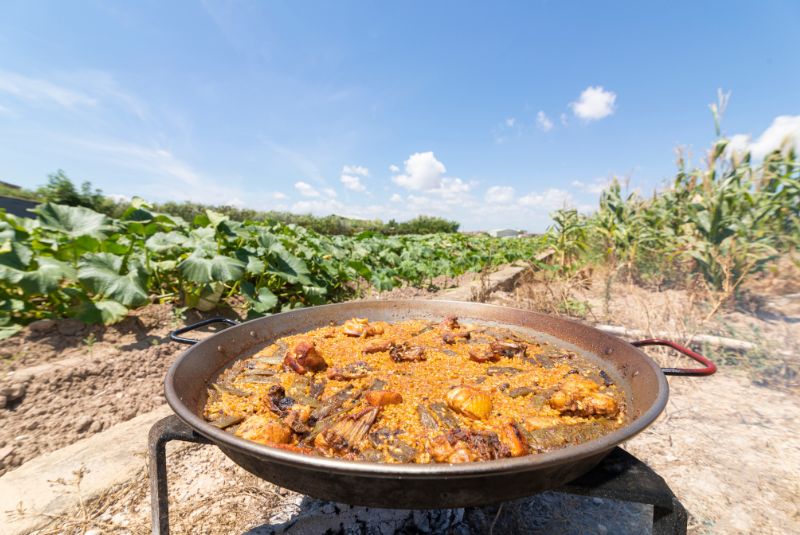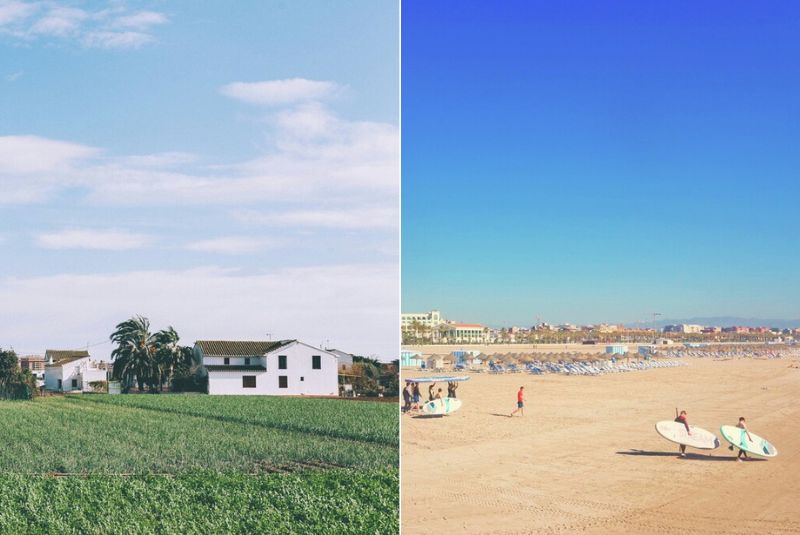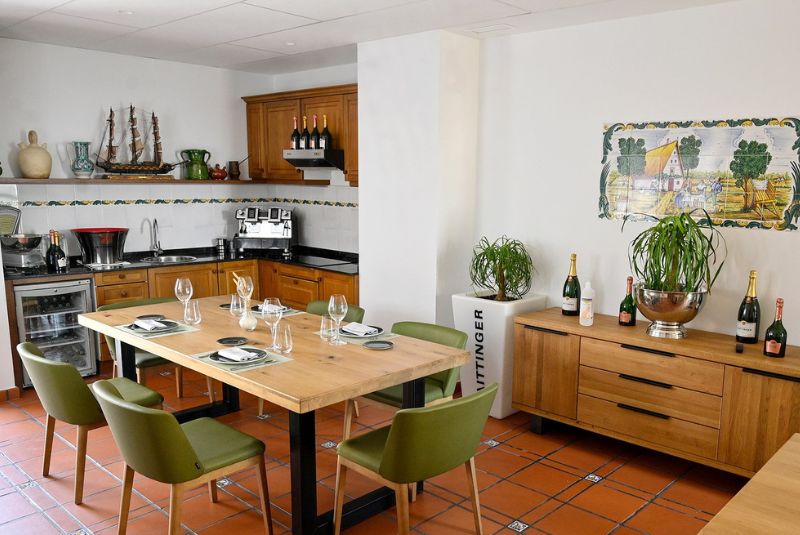As the city and region of Valencia prepares to host The World’s 50 Best Restaurants 2023, sponsored by S.Pellegrino & Acqua Panna, its most famous (and frequently bastardised) dish comes under the microscope. Let our insider’s take on paella – ingredients to include, how not to cook it, where to find the best versions – guide you to socarrat success
If Valencia is one of Spain’s great under-sung cities then paella, long established as Spain’s national dish, must surely be its most misunderstood. As Josep Pla, the great Catalan gastronome and journalist, described it: “One of the most perverted, humiliated dishes of the national cuisine.”
From the lurid yellow versions served fresh from the microwave to tourists all over Spain, to the chorizo and pea studded version which famously provoked the phrase: ‘Eso no es paella, eso es arroz con cosas,’ meaning ‘this is not paella, it’s rice with things,’ – few dishes are more maligned. And yet, should you choose to spend a day strolling Valencia’s sun-splashed boulevards, sipping chilled horchata (tiger nut milk) in the shade of an orange tree, nibbling tapas and gazing upon the dazzlingly beautiful Mercado Central before heading off for convivially long, wine-fuelled lunch of Paella Valenciana cooked over wood – specifically orange wood if you want to get serious about it – you’d be convinced of its rightful place as one of the greatest dishes of all time. This is a dish as unique, and as richly nuanced, as Spain itself.
Valencia is Spain's third largest city (photo courtesy of Visit Valencia)
Valencia is paella’s spiritual home: a region where eating it is a national sport and one that is deeply wrapped up in an identity around hospitality, community and culinary tradition that dates back centuries. In the spring of 2021, Valencia’s authorities, backed by chefs like Quique Dacosta and Ricard Camarena, called for it to be given Intangible Cultural Heritage status by the UNESCO World Heritage Committee. The application remains in process, but it’s still not uncommon to come across folks arguing ferociously about whether you should add water before rice, or rice after water; a sprig of rosemary to the pan as it cooks, or simply throw it onto the fire to enhance the flavour delivered by the wood smoke.
Suffice to say, in Valencia, rice is taken very seriously indeed. On 20th September every year, World Paella Day is celebrated, incorporating the World Paella Day Cup, no less (the current edition is open for entries from chefs).
Rice of life
The grain was introduced to the region during the Arabic occupation around the eighth century, when paddies were planted in the Albufera lagoon just south of the city. It’s been known as Spain’s rice capital ever since and by the early 18th century the first records of a dish named paella emerged.
Traditionally prepared by farm workers over open fires, it’s a combination of round-grain rice – Bomba, Senia or Albufera varieties – and local vegetables like ferraura (wide, flat green beans), artichokes, garrofó (creamy butter beans) and tavella (small white beans), as well as rabbit, chicken and duck. These ingredients were browned in a paella (a wide, flat, shallow pan ideally made of carbon steel), then stirred into a base of well-made sofregit (tomatoes fried in oil) and barely covered in saffron-flavoured water. It’s even been suggested in some circles that you can only truly achieve the proper taste by using water from Valencia.
Paella was traditionally prepared for farm workers over open fires (photo courtesy of Visit Valencia)
Then comes the key part: leave it well alone to cook. Stirring is an absolute no-no in order to form the highly prized socarrat – a caramelised layer of crunchy rice at the bottom – of a true Paella Valenciana. And according to lore, and the most strident of aficionados, it is best enjoyed eaten with an olive-wood spoon in the shade of a fig tree or a vine.
Inevitably, as Valencia prospered to become Spain’s third city, and the Costa Azahar (orange blossom coast) opened up to tourists, so traditional dishes from the countryside began to migrate to the cities and the shore and evolved to include ingredients typical to those areas: most notably in the form of seafood – paella de marisco – prepared with cuttlefish and prawns, mussels and clams. What it never included until it spread beyond Spanish borders were the chorizo and peppers, peas and – most outrageous of all – basmati rice, that crops up in myriad interpretations of the dish the world over.
Bound up in agricultural heritage, culinary expertise and cultural identity, it’s generally agreed that Paella Valenciana is the original and the best. Now, as The World’s 50 Best Restaurants prepares to arrive in Valencia, there’s never been a better time to take a deep dive into getting to know Spain’s emblematic dish.
Originating in the countryside, paella has evolved to include ingredients from the coast (photos courtesy of Visit Valencia)
Where to eat paella: six choices in and around Valencia
Restaurante Levante
Long-established as something of a pilgrimage site for authentic Valenciana paellas, Chef Rafael Vidal first opened in the village of Benisanó (about 20 minutes outside the city) in 1968. It’s still going strong but now has outlets in central Valencia as well as masterclasses for those who want to take their paella-making skills to the next level.
El Racó de la Paella
One of the last remaining places in Valencia itself where you can get an authentic wood-fired paella. This delightful restaurant occupies an old townhouse with original azulejo tiled dining rooms and wood beamed ceilings making a pitch-perfect backdrop to some serious Valenciana eating. Lunchtime only.
Casa Carmela
Founded in 1922 on Malvarrosa Beach, Casa Carmela is beloved by tourists and locals for seafood paellas using carefully sourced ingredients, on rice boasting a sublime socorrat delicately scented by smoke from the orange wood they still insist on using.
Casa Carmela opened in 1922 and serves paella cooked over orange wood (photo courtesy of Casa Carmela)
Casa Roberto
Tucked away in the historic El Carmen neighbourhood, this is chef Roberto Aparicio’s homage to the city’s signature dish. He now serves up around 150 traditional paella Valencianas a day replete with snails from the paddies, tender artichokes and impeccably cooked bomba rice.
Lavoe
Beloved by the city’s cool young food lovers, chef Toni Boix has taken the traditional components of authentic rice cookery learned at his father’s knee and elevated them into a highly focussed, contemporary dining experience.
L’Establiment
In the capital of the Albufera, El Palmar, there are several temples to rice, but none quite so elegant as L’Establiment, whose terrace juts out into the paddies. Expect excellent examples of hyper-regional dishes like all y pebre (eel stewed with potatoes, garlic and black pepper) as well as more unusual rice dishes like arroz en fessols i naps (rice with beans and turnips).
View this post on Instagram
The essentials: how to cook Paella Valenciana
First you need short-grain rice, ideally Bomba, Senia or Albufera varieties (looks out for the Valencia Denomination of Origin). Then gather saffron, olive oil, chopped tomatoes, garlic, green beans, butter or white beans, chicken, rabbit and salt. Heat your pan over a medium-high heat then add a generous amount of olive oil. Season the meat well, brown, and remove from the pan. Add the green beans and cook until they soften and start to char. Add the tomatoes to the pan with the beans and cook until they soften, then return the meat. Dissolve the saffron in hot water. Bring the heat up to high, sprinkle the rice over the other ingredients in a thin layer, stirring briskly to combine. Pour the saffron water over the rice so it covers it by about one finger's width. Add a small branch of rosemary. Reduce the heat to a simmer, but avoid stirring the rice from this point onward. Cook for 10 to 15 minutes, until the water has mostly evaporated and the rice is tender and still moist. Remove the rosemary and bring the heat up to medium high for 1-2 minutes to ensure a golden socarrat. Let the rice rest for 5 minutes before serving, and always serve directly from the pan.
The 21st edition of The World’s 50 Best Restaurants list, sponsored by S.Pellegrino & Acqua Panna, will be announced on 20th June 2023 in Valencia. Tune in to the livestream of the awards ceremony on YouTube or Facebook from 20:40 local time. To stay up to date with the news and announcements ahead of the ceremony, browse the website join the community on Instagram, find us on Facebook, visit us on Twitter and subscribe to our YouTube channel.
.jpg)
